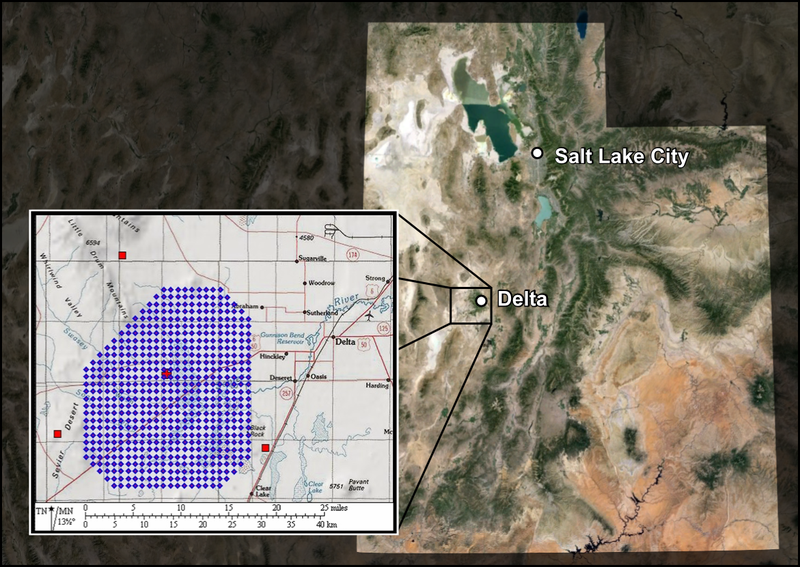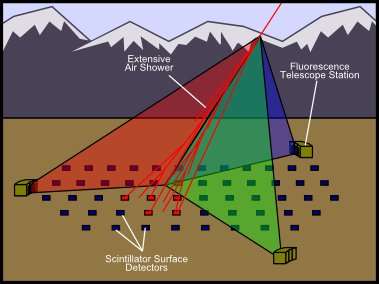Scientists from the Telescope Array Collaboration have detected an ultrahigh-energy cosmic ray, a discovery that’s challenging our current understanding of exotic cosmic phenomena and their origins.
In a study published today in the journal Science, the Telescope Array Collaboration has reported the detection of an ultrahigh-energy cosmic ray (UHECR for short), which exhibits an energy level of approximately 244 exa-electron volts, or roughly 40 Joules. This measurement, taken by a surface detector array in Utah, represents one of the highest energy levels ever observed for cosmic rays. For context, this observed energy level is approximately one million times higher than what the most powerful human-made particle accelerators can produce, according to the researchers.
The Telescope Array project is a joint effort involving universities and institutions from the United States, Japan, Korea, Russia, and Belgium, and its purpose is to monitor “air showers” caused by cosmic rays of extremely high energy. Unseen to the unaided eye, our planet is continually bombarded with these cosmic rays, originating from both local sources within our galaxy and distant extragalactic regions. To be clear, these space rays are nothing to worry about; Earth’s atmosphere and magnetic field offer effective protection against cosmic rays, significantly reducing their potential to cause harm to humans and other forms of life.

The Telescope Array in Utah detects extremely rare, high-energy cosmic rays using a network of 507 detection stations spread over 270 square miles (700 square kilometers). These stations capture secondary particles that form when cosmic rays hit the atmosphere, creating extensive air showers (EAS). The system includes plastic scintillators that glow when charged particles pass through them and fluorescence detectors for measuring the energy of the EAS. Data from the stations, analyzed using GPS timing and simulations, helps determine the cosmic ray’s energy, mass, and arrival direction, despite their scarce occurrence.
Indeed, UHECRs like the one described in the new study are incredibly rare and thought to originate from the most energetic processes in the universe, such as black holes and gamma-ray bursts. Due to their infrequent arrival—less than once per century per square kilometer—these cosmic rays necessitate large detectors for observation. The May 2021 event is therefore a big deal for cosmic ray research.

The source of this extragalactic cosmic ray, detected on May 27, 2021, remains an enigma, as its incoming direction does not align with any known astronomical objects. The cosmic ray’s arrival path, situated near the Milky Way’s disk, suggests that it likely experienced only minor deviations when zipping through magnetic fields (which are ubiquitous throughout the galaxy, whether they be large-scale magnetic fields or localized magnetic fields generated by stars, supernova remnants, and other celestial objects). This means the cosmic ray likely traveled almost straight from where it came from, the researchers say.
That said, its source direction does not correlate with any known galaxies or astronomical objects typically associated with UHECRs. Instead, it appears to have originated from a void in the universe’s structure—an empty region with very few galaxies. For you astronomy nerds out there, it’s specifically the Local Void, an empty gap between the Local Group of galaxies and the nearby Large-Scale Structure filaments; very few galaxies have been documented within this void, none of which were deemed capable by the researchers of excreting such a powerful cosmic ray.
Related article: Hubble Snaps a Gorgeous Pic of the Universe’s Loneliest Galaxy
According to the paper, the cosmic ray’s unexpected incoming trajectory could be the result of it being significantly redirected by magnetic fields closer to us, or it might have originated from a yet-to-be-discovered astronomical object near the outskirts of our galaxy. Alternatively, this anomaly could reveal gaps in our current understanding of the physics governing such high-energy particles, the astronomers speculate.
To further investigate, the researchers compared the event with other observed UHECRs above 100 exa-electron volts, or EeV, and found an isotropic distribution, meaning these cosmic rays appear to come from all directions in space evenly, without clustering. This isotropic pattern adds another layer of complexity in pinpointing their origins.
Historically, other high-energy cosmic rays have been detected, such as a 320-EeV particle in 1991, a 213-EeV particle in 1993, and a 280-EeV particle in 2001, all in the Northern Hemisphere. The Southern Hemisphere has not recorded events above 166 EeV. These comparisons are vital for understanding the distribution and origin of such high-energy events, so hopefully future observations will provide further insights and potentially reveal new patterns or sources.
While this detection is important for cosmic ray research, it raises more questions than answers about the origins and mechanisms of these high-energy particles. The findings from the Telescope Array experiment offer a new perspective on the mysteries of the universe, yet they also underscore the vastness of our unknowns in astrophysics.
